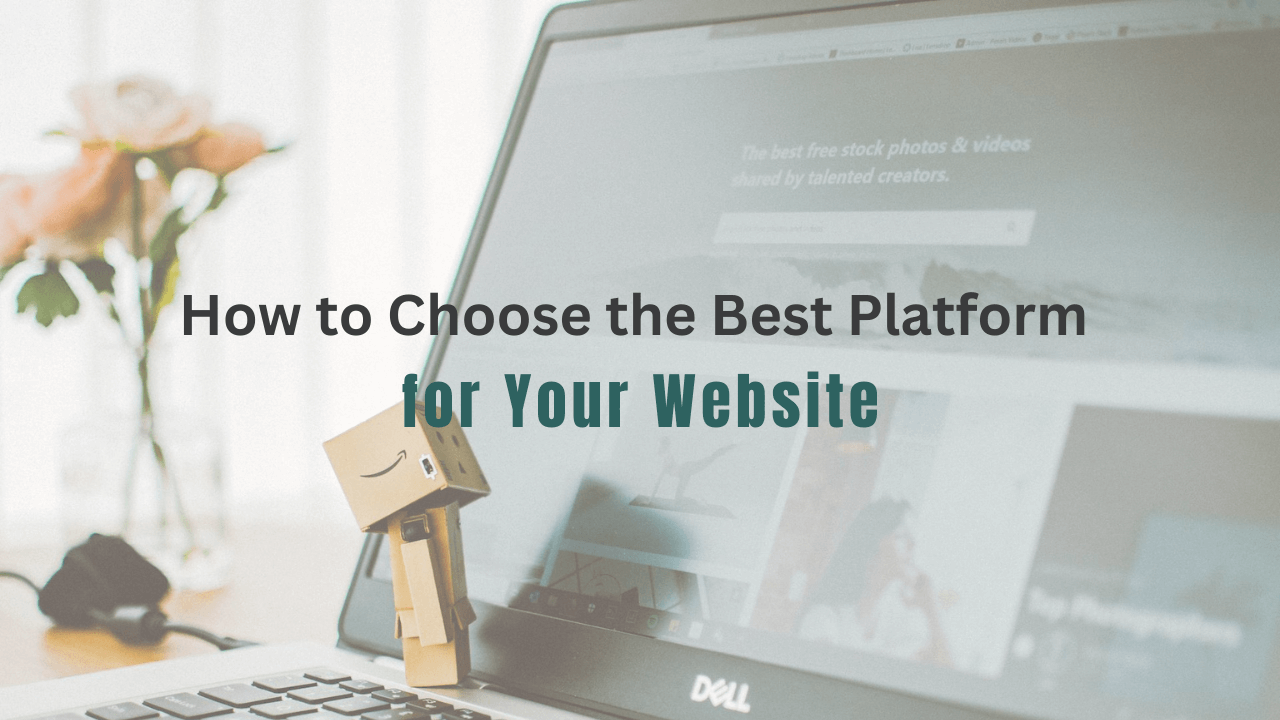How to Choose the Best Platform for Your Website
Building your first website is exciting, right? The possibilities feel endless, and it’s like opening a door to a whole new world. But then reality hits, and you realize you have no idea which platform to choose. WordPress, Wix, Shopify, Squarespace—each one sounds great, but the more you read, the more confusing it gets. Do you want flexibility? Do you need an easy drag-and-drop experience? Maybe you’re starting an online store, or maybe you’re just getting your blog off the ground.

Trust me, I’ve been there. I spent days, maybe even weeks, bouncing between platforms like a ping pong ball, only to end up even more unsure of what I needed. I’d get excited about a feature, only to discover a huge flaw later on. After tons of trial and error, I finally learned that the key to picking the right platform comes down to understanding your goals, your budget, and your technical skills.
Choosing the right platform shouldn’t feel like a guessing game. It should be based on your needs, what you want to achieve with your website, and how much time and effort you’re willing to put in. I’ll guide you through all the options and give you a clearer picture of what each platform can offer, so you can make a decision without the headache. Ready to dive in? Let’s find the platform that’s the perfect fit for you!
Table of Contents
ToggleWhat to Consider When Choosing a Website Platform
Picking a website platform is kind of like choosing a new apartment. You want it to look good, feel right, and—most importantly—not turn into a nightmare six months down the road. I’ve made the mistake of going for something “easy” only to realize later that it didn’t have the flexibility I needed. So, before you commit, here’s what to consider:
Ease of Use: Drag-and-Drop vs. Coding Flexibility
Are you the type who loves tweaking every little detail, or do you just want to drag, drop, and be done? Wix and Squarespace are perfect if you want a beginner-friendly, visual editor—zero coding required. WordPress and Webflow, on the other hand, give you way more control but come with a learning curve. Shopify is somewhere in between: easy enough for beginners, but with advanced options for those who want to customize.
Customization Options: Templates vs. Full Design Control
Templates are a lifesaver when you want something that looks professional without hiring a designer. Platforms like Squarespace and Wix offer stunning, pre-made designs that you can tweak, while WordPress and Webflow let you customize literally everything (if you know what you’re doing). Shopify? Great for eCommerce, but the design options can feel a bit boxed in unless you’re comfortable with coding.
Scalability: Can the Platform Grow with Your Business?
Right now, you might just need a simple website, but what about in a year? If you plan to add a blog, membership area, or an online store later, make sure your platform can handle it. WordPress and Shopify are excellent for long-term growth, while Wix and Squarespace can be limiting once your needs get more complex.
Cost: Free vs. Premium Options and Hidden Fees
Let’s talk money. WordPress (the .org version) is technically free, but you’ll pay for hosting, themes, and plugins. Wix and Squarespace have predictable monthly fees, but they can get expensive if you need advanced features. Shopify starts at a fixed price, but transaction fees and app costs add up fast. My advice? Look beyond the starting price and check for hidden fees before committing.
SEO and Performance: How Does the Platform Impact Rankings?
If you want to rank on Google, your platform matters. WordPress (with the right SEO plugins) gives you the most control over optimization. Shopify and Webflow are also solid, but Wix and Squarespace have a reputation for weaker SEO (though they’ve improved over the years). Also, check how fast the platform loads—slow sites drive visitors away.
Security and Support: Built-in Security Features and Customer Support Options
The last thing you want is your site getting hacked or going down with no one to help. Shopify and Squarespace handle security for you, while WordPress leaves it up to you (meaning you need good hosting and security plugins). Customer support is also a biggie—Wix, Squarespace, and Shopify have 24/7 support, while with WordPress, you’re mostly relying on forums and hosting providers.
Choosing the right website platform is a balance between what you need now and where you see your business going. If you want full control, WordPress is king. If you want easy, Wix or Squarespace are solid. If you’re building an online store, Shopify is the safest bet. Whatever you choose, make sure it’s a platform you’re comfortable with—because trust me, switching later is a pain!

Popular Website Platforms Compared
WordPress – The Most Flexible and Powerful CMS
To have a complete control over your website, WordPress is your platform to go. It powers over 40% of the internet, which says a lot. With thousands of themes and plugins, you can build anything from a simple blog to a massive eCommerce store. But here’s the catch – WordPress isn’t beginner-friendly. You’ll need to manage hosting, security, and updates yourself. If you’re okay with a learning curve, it’s hands-down the most scalable option.
Wix – Beginner-Friendly Drag-and-Drop Website Builder
If you want to get a website up fast without touching a line of code, Wix is a solid option. It’s got an intuitive drag-and-drop builder, and the templates look pretty sleek. It’s perfect for personal brands, small businesses, and creatives who don’t need a ton of custom features. Just be aware that once you pick a template, you can’t switch it later—so choose wisely!
Squarespace – Stylish and Design-Focused for Creatives
For someone who specifically care about aesthetics, Squarespace is like the Apple of website builders—beautiful, polished, and easy to use. It’s great for photographers, designers, and anyone who wants a visually stunning site without hiring a designer. SEO and customization are a bit limited compared to WordPress, but if you want something that looks amazing right out of the box, this is it.
Shopify – The Best Choice for eCommerce Businesses
Shopify is the easiest and most reliable platform for eCommerce. It’s built specifically for online stores, meaning it has everything—secure payments, inventory management, and a ton of apps to add functionality. The downside? It’s not the cheapest, and customization can be tricky unless you know Shopify’s Liquid coding language. But if making sales is your main goal, Shopify is a no-brainer.
Kajabi – All-in-One Platform for Course Creators
For someone in the online course and coaching space, Kajabi is a perfect fit. It’s not just a website builder—it also includes email marketing, course hosting, and sales funnels all in one platform. That means you don’t have to duct-tape a bunch of tools together. The catch? It’s on the pricier side, but if you’re selling digital products, it might be worth it for the convenience alone.
Webflow – Advanced Design Capabilities Without Full Coding
If you want pixel-perfect design control but don’t want to dive deep into coding, Webflow is a game-changer. It’s like a mix between WordPress and a visual design tool, letting you build complex layouts without relying on a developer. It’s got a steeper learning curve than Wix or Squarespace, but if you want a highly customized site without hiring a coder, it’s worth checking out.
The best platform depends on what you need. If you want total control, go with WordPress. If you need ease of use, Wix or Squarespace are great. Selling products? Shopify. Creating online courses? Kajabi. And if you want high-end design flexibility, Webflow is the winner. Choose wisely—because switching platforms later is a headache you don’t want!
Best Website Platforms by Use Case
Best for Blogging – WordPress vs. Medium
If you’re serious about blogging, WordPress is the gold standard. It gives you complete control over your content, SEO, and design. You can monetize your blog with ads, affiliate links, or memberships—whatever works for you. The downside? It requires some setup, like choosing a host and managing updates.
Medium, on the other hand, is plug-and-play. You don’t need to worry about design or hosting—just start writing. But here’s the catch: you don’t own your audience. Medium controls the algorithm, meaning your reach can fluctuate. If you want long-term growth and full ownership, WordPress is the winner. But if you just want a no-fuss writing platform, Medium works.

Best for eCommerce – Shopify vs. WooCommerce vs. BigCommerce
For selling products online, Shopify is the easiest and most beginner-friendly option. It handles everything—payments, inventory, shipping, and even marketing tools. But it comes with monthly fees, and advanced customizations might require a developer.
If you already use WordPress, WooCommerce is a powerful (and free) eCommerce plugin. It’s super flexible, but you’ll need to manage hosting, security, and plugins yourself. It’s great if you want full control but requires more technical know-how.
BigCommerce is similar to Shopify but geared toward larger businesses. It has more built-in features, so you won’t need as many third-party apps. If you plan to scale quickly, BigCommerce is worth considering. If you just need a simple store, Shopify is the easiest way to go.
Best for Small Businesses – Wix vs. Squarespace vs. Kajabi
If you’re a small business owner who just needs a sleek, functional website, Wix is an easy choice. It’s got a simple drag-and-drop editor and plenty of templates. But keep in mind that once you choose a template, you can’t change it later.
Squarespace is perfect for businesses that want a more polished, design-forward site. It’s especially great for restaurants, photographers, and service providers. It’s a bit more structured than Wix but offers beautiful templates that look professional right away.
For businesses based on selling online courses or memberships, Kajabi is a better fit. It’s an all-in-one platform that lets you create a website, host courses, and handle marketing in one place. It’s pricier but eliminates the need for multiple tools.
Best for Portfolio Sites – Squarespace vs. Webflow
If you’re a designer, photographer, or creative, you want a site that looks stunning without a ton of hassle. Squarespace is a great option because its templates are modern and visually appealing. It’s easy to use, and you don’t need coding skills to make your site look professional.
For complete design control, Webflow is the way to go. It offers pixel-perfect customization and advanced animations without requiring a developer. The learning curve is steeper, but if you want a unique, highly customized portfolio, Webflow is unbeatable.
Best for Membership Sites – WordPress with Plugins vs. Kajabi
If you’re building a membership site, WordPress + plugins like MemberPress or Restrict Content Pro gives you maximum flexibility. You can customize pricing, content access, and design however you want. But you’ll have to handle hosting, security, and plugin updates yourself.
In case yu need an all-in-one membership site solution, Kajabi is a solid choice. It includes website hosting, email marketing, and a built-in course/membership system. The downside? It’s more expensive, but it saves you from piecing together multiple tools.
Choosing the right platform depends on your goals. WordPress dominates for blogging and memberships, Shopify is best for eCommerce, and Squarespace shines for creatives. If you need simplicity, Wix is great, while Webflow is for advanced designers. And if you want an all-in-one business platform, Kajabi is worth considering. Pick what fits your needs now, but also think about where you want your site to go in the future!
SEO and Performance: Which Platform Ranks Best?

If you’ve ever waited more than three seconds for a website to load and immediately hit the back button, congratulations—you just proved why website speed matters for SEO. Google prioritizes fast-loading sites because users expect instant results. Slow websites lose visitors, and fewer visitors mean lower rankings.
Platforms like WordPress (with a good host), Webflow, and Shopify tend to perform well in speed, while Wix and Squarespace can lag if not optimized properly.
Mobile-Friendliness and Responsive Design Considerations
Here’s the deal: more than half of all web traffic comes from mobile devices. If your site isn’t mobile-friendly, Google will push you down the rankings faster than you can say “SEO disaster.” Most platforms claim to be mobile-responsive, but some do it better than others. Webflow and WordPress (with the right theme) offer full customization to ensure a great mobile experience, while Wix and Squarespace rely on pre-set responsive designs that may not be as flexible.
Built-in SEO Tools vs. Manual Optimization
Some platforms give you SEO training wheels, while others expect you to handle everything yourself. WordPress (with Yoast or Rank Math), Shopify, and Webflow offer robust SEO tools that let you tweak meta titles, descriptions, and schema markup. Wix and Squarespace, on the other hand, have built-in SEO tools, but they’re more basic—you get control over meta tags and alt text, but you might struggle with deeper optimization like structured data. If you want full control, WordPress is king.
The Importance of Clean Code and Fast-Loading Themes
Here’s a secret most beginners don’t think about: your website’s backend code matters. Messy, bloated code slows your site down, which can hurt your SEO. Platforms like Webflow and WordPress (with lightweight themes like GeneratePress or Astra) produce clean, fast-loading sites. Meanwhile, Wix and Squarespace often have extra code that can slow things down. If speed is your priority, avoid overly complex themes and stick with minimalist designs that load quickly.
If SEO is your main focus, WordPress (self-hosted) and Webflow are your best bets, giving you full control over optimization. Shopify is solid for eCommerce, while Wix and Squarespace are decent but require extra effort to keep up. Regardless of your platform, fast hosting, lightweight themes, and strong SEO fundamentals will make the biggest difference in your rankings.

Pricing Breakdown: Which Platform Fits Your Budget?
When it comes to building a website, pricing is one of the first things that comes to mind—and rightfully so! Choosing the right platform doesn’t just depend on how great it looks or how easy it is to use, but also how much it will cost you in the long run. There’s no one-size-fits-all answer, but I’ll break down the key expenses you’ll need to think about to help you decide which platform is the best fit for your budget.
Free vs. Paid Website Platforms
Let’s start with the basics: free vs. paid platforms. Free platforms like Wix and Weebly offer basic plans that allow you to create a site without spending a dime. But here’s the catch—they often come with limitations like branding (e.g., “yourname.wixsite.com”) and fewer customization options. Paid platforms, such as WordPress.org (self-hosted) and Shopify, give you more flexibility, control, and better features, but they also come with ongoing costs. For WordPress, you’ll need to pay for hosting, domain, and themes, while Shopify includes hosting and domain in its pricing plans but has higher monthly fees.
Hosting and Domain Costs
When you’re choosing a platform, consider that hosting and domain registration often aren’t included in the base price, especially with WordPress. You’ll need to pay for hosting separately, which can range from as little as $3 to $10 per month, depending on the host and the plan you choose. Platforms like Wix, Squarespace, and Shopify bundle hosting into their pricing, making it easier for beginners, but it can end up being pricier in the long run. For example, Shopify plans start at $39/month, while Wix starts at $14/month, but you can expect to pay more as your business grows and you add extra features.
Additional Expenses (Themes, Plugins, Extensions)
Once you’ve got the basics covered, you may start looking at themes, plugins, and extensions—especially if you want to give your site that extra flair. WordPress offers tons of free themes and plugins, but if you want premium features, you’ll likely have to pay for them. Premium themes can cost anywhere from $20 to $100, and plugins (for SEO, security, etc.) can add up quickly. Similarly, Shopify and Webflow offer paid extensions that let you add more functionality, and these can range from a few bucks to $100+ per month, depending on what you’re looking to add.
Which Platforms Offer the Best Value for Money?
If you’re on a tight budget, Wix and Weebly provide excellent free and low-cost options for small websites, though be prepared for those upsells. WordPress offers great value too, especially if you’re comfortable with some tech—your hosting and domain are separate costs, but you have endless control and customization. For eCommerce, Shopify is excellent but comes with a higher cost for the features and convenience it offers, especially when you need to expand your online store. For a more design-focused website with minimal fuss, Squarespace strikes a balance between cost and design features but may be more expensive than a basic WordPress setup.
There’s no right or wrong when it comes to website pricing—it all depends on your goals and budget. If you’re just getting started and need something simple, Wix or Weebly can give you a website with a lower cost of entry. If you’re serious about building something with room to grow, WordPress offers flexibility at a lower price point but requires more effort. Meanwhile, if you’re running an eCommerce site, Shopify might feel steep at first, but its all-in-one solution can save you a ton of time and energy.

Making Your Final Decision: Which Platform is Right for You?
Alright, you’ve done your research, you’ve weighed the pros and cons, and now it’s time to make a decision. But how do you know which platform is really the right one for you? Don’t worry, I’ve got you covered with a handy checklist and some key questions you should ask yourself before jumping in.
Checklist to Determine Your Needs
Before choosing a platform, take a step back and ask yourself a few key questions about your goals and how you plan to use the website.
- Are you creating a blog, an eCommerce store, or a portfolio? This can drastically change your decision.
- If you’re looking to create a blog, WordPress is unbeatable for flexibility and content management.
- For the online store, Shopify will give you more eCommerce features than most other platforms.
- Also, think about your technical skills. If you’re a beginner, you might want to stick with something like Wix or Squarespace, which are both super user-friendly. On the other hand, if you’re ready to get into the weeds and build something more custom, WordPress and Webflow are your best bet.
Questions to Ask Before Committing to a Platform
Now that you’ve got a rough idea of what you need, here are a few questions to make sure you’re on the right track before committing:
- How much control do I want over my site’s design? – Platforms like Squarespace and Wix offer pre-designed templates, but if you want complete creative freedom, Webflow or WordPress might be a better option.
- What’s my long-term vision? – Think about scalability. Will the platform grow with you as your business or blog expands? For example, Shopify is great for small stores, but if you want to expand to a full-fledged marketplace, you may want something more flexible like WooCommerce (on WordPress).
- Do I need special features? – Consider things like membership sites, subscription models, or advanced SEO tools. If this is you, platforms like Kajabi (for memberships) or WordPress (with plugins) will give you the most options.
Trial Periods and Free Versions – Test Before You Buy
Don’t forget to test drive the platform before fully committing. Most platforms, like Wix, Squarespace, and Shopify, offer free trials, so take advantage of them! This will give you a feel for how easy it is to use and if the platform’s features really meet your needs.
Even if a platform offers a free version, keep in mind that there may be limitations—like ads or restrictions on features—so make sure you’re aware of what you’re getting into.
Migration Options if You Need to Switch Later
I’ve been there, trust me: you pick a platform, and a few months down the road, you realize it doesn’t work as well as you thought. The good news is that you can switch platforms, but it’s not always easy. Some platforms, like WordPress, offer a lot of flexibility if you want to migrate your site elsewhere, while others, like Wix and Shopify, make it harder (but not impossible).
So, before you dive in, think about the long-term. If you think you might need to move platforms at some point, check if the platform allows easy export or migration. That way, you won’t get stuck with your site and its content locked in a platform you’ve outgrown.
Choosing the right platform isn’t easy, but asking the right questions can make the decision clearer. Do you want something simple and user-friendly? Go for Wix or Squarespace. Need full control and flexibility? WordPress or Webflow might be for you. If you’re building an eCommerce store, Shopify should definitely be on your radar. Ultimately, take the time to test a few options, and make sure the platform you choose matches your needs, budget, and long-term goals. Happy building!
Choosing the best platform for your website really comes down to finding that sweet spot between ease of use, flexibility, cost, and performance. It’s not just about picking the most popular option; it’s about choosing the one that fits you. Whether you’re a blogger looking to share your thoughts, an entrepreneur ready to launch your business, or an eCommerce seller aiming to build your online store, there’s a platform that can help you do it all.
Don’t rush the decision. Take full advantage of free trials, explore all your options, and make sure the platform you choose aligns with your long-term goals. Your website is your digital home—take the time to make sure it’s built on a solid foundation that will grow with you.
Ready to take the next step in building your website? Whether you’re starting from scratch or looking to optimize your current site, I’m here to help! Visit my website services page to explore how I can assist you in creating a website that works for you.

